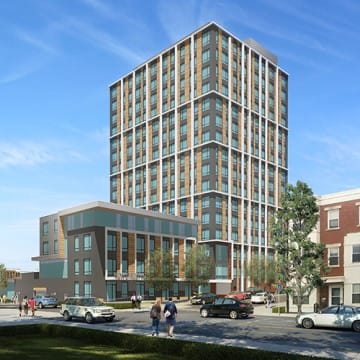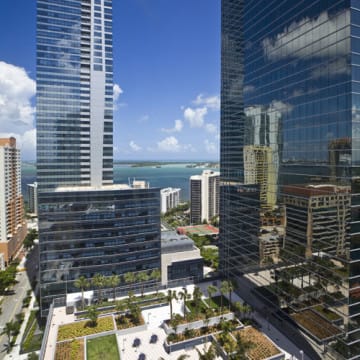National Landing
At National Landing, the neighborhood that will soon host Amazon’s famed Arlington headquarters site, heat and humidity are major issues for developer JBG Smith. Much of the area includes office development constructed in the 1960s and 1970s, featuring superblocks and expansive plazas, often without significant vegetation. To make the district more attractive to prospective tenants—Amazon and others—JBG Smith initiated a comprehensive placemaking plan to improve the area’s streetscape, sidewalks, parks, and other outdoor gathering spaces in mid-2017.
To create this vibrant and climatically comfortable environment, JBG Smith is testing a reflective pavement sealant as an urban heat island mitigation strategy as well as installing additional trees, green space, and green roofs. Crystal City’s climate action plan notes that “quality of life will be affected by increasing heat stress, . . . severe weather events, and reduced availability of insurance for at-risk properties.” Today, the region experiences 30 dangerously hot and humid days each year; however, climate projections indicate 30 to 45 more of these heat emergency days per year by 2050.
Initiatives to improve sustainability and build resilience are critical to successfully accommodating continued growth in the region and enhancing the community’s quality of life. — Tracy Gabriel, President and Executive Director, Crystal City Business Improvement District
Excluding Amazon’s proposed land purchase, JBG Smith controls 7.4 million square feet of development opportunities and owns 6.2 million square feet of existing office space and 2,850 multifamily units in National Landing, which is located across the Potomac River from Washington, D.C., and comprises Crystal City, the eastern portion of Pentagon City, and Potomac Yard. The reflective paving pilot project is key to JBG Smith’s efforts to enhance the pedestrian experience. In an interview for a local paper, JBG Smith’s chief development officer, Brian Coultner, reported, “We’re really excited about the possibility and potential of this. If this has the type of impact we’re looking for…it will work well for the people who visit and the people who live there.”
Extreme Heat Resilience Strategies
In October 2018, JBG Smith installed 550 gallons of reflective coating over 17,000 square feet in the core of the National Landing district. The size of the National Landing site and the concentration of JBG Smith’s holdings “provides an incredible opportunity to try new innovative technologies” says Bryan Moll, executive vice president of development. The test site is a private driveway between two office buildings (two of which will be occupied by Amazon) that will have low to moderate traffic.
The reflective sealant is a gray-colored, water-based asphalt emulsion sealcoat (a mix of asphalt cement with additional minerals, polymers, and emulsifiers; it is not a paint) designed to be 33 percent reflective. Typically, two coats are applied to ensure 100 percent coverage of the underlying asphalt. The reflective paving costs $2.40 per square foot, in addition to the underlying asphalt.
JBG Smith’s pilot project costs are about $40,000, including installation. Installation of the sealant took about two weeks.
We were looking to incorporate a number of sustainable technologies throughout the district, and we knew reflective paving is a relatively new product on the East Coast. –Bryan Moll, Executive Vice President of Development, JBG Smith
Outcome
JBG Smith plans to evaluate the impact of the pavement on local surface and air temperatures as well as on pedestrian experience during summer 2019. “We are going to be measuring how it stands up and how it measures in humid heat,” explained Ayisha Swann, development associate with JBG Smith. The firm anticipates hiring a consultant to conduct temperature readings, considering both the magnitude of the impact adjacent to the installation and the geographic range of that effect. Engineers will also critique the product’s durability through a visual assessment.
If the product is successful in mitigating temperature, JBG Smith anticipates continuing to test the product on other parts of the National Landing site with differing amounts of pedestrian and vehicular traffic. “The immediate next steps may be secondary streets, including private or semi-private streets,” explained Moll. “If we end up finding that this product is everything we hoped for, the end game would be applying it to highly trafficked roads.” A large-scale application would present opportunities for partnership with Arlington County, which owns most of the roads within National Landing.
Ultimately, urban heat island mitigation represents an important component of the placemaking, sustainability, and future development strategy for National Landing. Amazon is investing $2.5 billion in the area for its second headquarters, and $1.8 billion from state and local governments and nearby universities Virginia Tech and George Mason University will fund, among other initiatives, two new Metro entrances, a pedestrian bridge, and a commuter rail hub. The transit improvements are adjacent to JBG Smith’s holdings.


